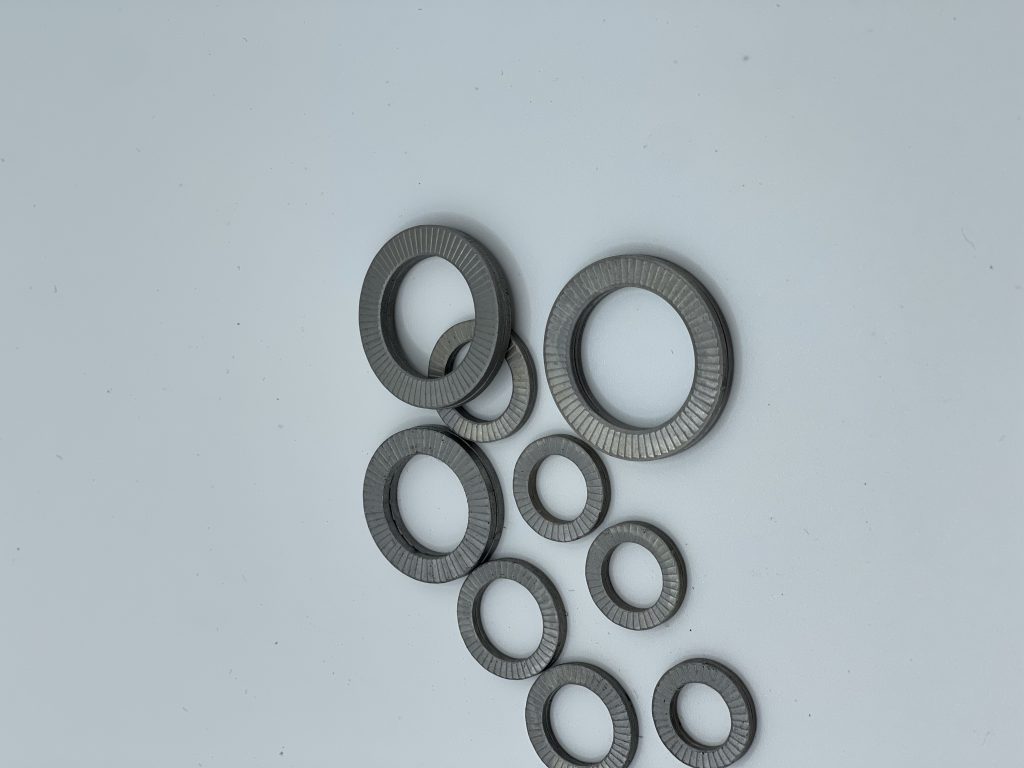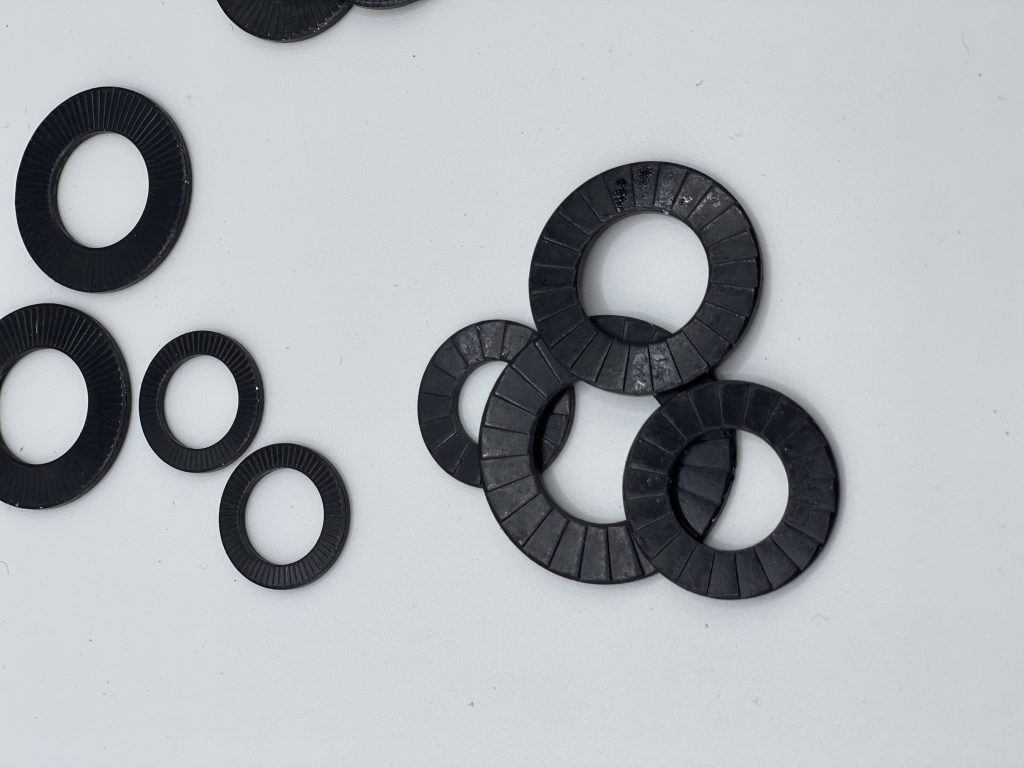

NL6 double stack self-locking washer is a washer for fasteners with self-locking function. It adopts double-layer structure, which can provide more reliable sealing and fixing under the condition of bearing high pressure and vibration. NL6 gaskets are usually made of elastic materials, such as stainless steel, copper, aluminum, etc., which have good corrosion resistance and fatigue resistance. Usually used in machinery, aerospace, automotive, military and other fields.
What are the characteristics of NL6 double-stack self-locking washers?
The NL6 double stack self-locking washer is an anti-loosening fixing element with the following characteristics:
Good self-locking performance: Since the washer adopts a double-stack structure, when the nut is tightened, the friction generated between the double-layer washers makes it difficult to loosen.
Good shock-proof and shock-absorbing effect: the gasket can play the role of buffering and shock-absorbing during use, effectively reducing the noise and vibration of the machine and equipment during operation.
Long service life: The gasket is made of high-strength spring steel, which is resistant to high temperature and corrosion, and has a long service life.
EASY INSTALLATION: The washer is compact and easy to install without the use of special tools.
Wide range of application: the gasket is suitable for the joints of various machinery and equipment, such as automobiles, ships, construction, home appliances and other fields.
What is the structure of the NL6 double-stack self-locking washer?
NL6 double-stack self-locking washer is a kind of elastic element, which is usually used between connecting bolts and nuts to prevent joints from loosening or losing tightening force. Its structure mainly consists of the following parts:
Outer ring: The outer ring is a circular part made of thin plate, and its inner diameter is comparable to the diameter of the nut. There are racks on the outer ring to create friction with the surface of the nut to increase the tightening force.
Inner Ring: The inner ring is a circular part made of thin plate with an outer diameter slightly smaller than the bolt diameter. The inner ring also has some racks, which cooperate with the racks on the outer ring to produce a self-locking effect when the nut is tightened.
Elastic gasket: The elastic gasket is located between the inner ring and the outer ring, and is a spring piece with a wave structure. When the nut is tightened, the elastic washer will be squeezed and deformed, thereby increasing the fastening force of the connecting rod. At the same time, the elastic spacer also absorbs vibration and shock, and maintains a stable fastening force.
Locking piece: The locking piece is the core part of the washer, which is located between the inner ring and the elastic washer. The material of the locking piece is usually a high-strength steel plate with good hardness and toughness. After the nut is tightened, the locking piece will be stretched and form a groove, so that the pressure between the inner ring and the outer ring is balanced, thereby realizing the self-locking function of the washer.
The above are the structural elements of the NL6 double-stack self-locking washer.
What is the function of NL6 double stack self-locking washer?
NL6 double-stack self-locking washers are usually used in bolt and nut joints, and its function is to increase the fastening force and anti-loosening ability of the connection. The double-layer design of the washer allows one layer of the washer to compress when the bolt is tightened, while the other layer “locks” onto the nut, preventing the nut from loosening due to external forces such as vibration. In addition, the gasket can also distribute the pressure between the connected parts and protect the connected parts from damage.
What are the application cases of NL6 double-stack self-locking washers?
NL6 double stack self-locking washer is a part commonly used in fastener assembly. Its main function is to prevent loosening or failure when the fastener is fixed. Here are a few application examples:
Automobile manufacturing: NL6 double-stacked self-locking washers are widely used in the assembly of parts in automobile manufacturing, such as engines and gearboxes.
Mechanical equipment: NL6 double stacked self-locking washers are also suitable for fastener assembly of various mechanical equipment, such as airplanes, trains, ships, cranes, etc.
Electronic products: In some electronic products that require high precision, such as computers and mobile phones, NL6 double-stack self-locking washers are also used to ensure the stability of fasteners.
In conclusion, NL6 double stacked self-locking washers are widely used in industrial production and manufacturing fields.
What are the dimensions of NL6 double stack self-locking washers?
The dimensions and specifications of NL6 double-stack self-locking washers can be customized according to specific needs. Usually, its size specifications include the following aspects:
Diameter (D): This refers to the thread diameter or bolt diameter for which NL6 double stack self-locking washers are applicable.
Inner diameter (d): This refers to the size of the inner diameter of the NL6 double stack self-locking washer, that is, its hole diameter.
Thickness (t): This refers to the thickness of NL6 double-stacked self-locking washers, usually in millimeters.
In addition to the above three main dimensions, there are other possible parameters, such as the number of teeth, materials, etc., which can be customized according to specific needs.
It should be noted that different application scenarios and working environments have different requirements for the size and specification of NL6 double stacked self-locking washers, so when selecting and using this product, it is necessary to determine the appropriate size and specification according to the actual situation.
What is the difference between NL6 double-stack self-locking washers and split washers?
Both NL6 double-stack self-locking washers and split washers are common types of washers in fasteners, and there are the following differences between them:
Structure: NL6 double-stack self-locking washer is composed of two concentric elastic disc springs, which can provide better self-locking function. Split washers, on the other hand, consist of a flat spring ring, which can only play a certain cushioning role.
Self-locking performance: NL6 double-stacked self-locking washers have good self-locking performance, which can prevent thread loosening and washer slippage during use. The split washer has no self-locking function, so it needs to be combined with other fasteners to ensure the fastening force when used.
Scope of application: NL6 double stacked self-locking washers are suitable for high-strength fastener connections, such as automobiles, mechanical equipment and other fields. Split washers are typically used for low-strength fastener connections.
Installation method: NL6 double-stack self-locking washers need to be installed by torque or pressure to ensure its good self-locking performance. Split washers, on the other hand, can be placed directly on the threads or bolts.
Can lock washers and lock nuts be used together?
Generally, lock washers and lock nuts can be used together to increase the security of fasteners. This combination can effectively prevent the thread from loosening or falling off.
Lock washers and lock nuts are commonly used fastener accessories. They increase the friction or locking force of fasteners through different mechanisms to prevent loosening or falling off. Lock washers usually use spring deformation or special geometric structures to generate internal tension, thereby increasing the friction between the washer and the fastener; while lock nuts increase the locking force with the thread through their internal structure or surface treatment .
In practice, lock washers and lock nuts work together to enhance the security of the fastener. For example, where higher tightening force and loosening resistance are required, a lock washer and lock nut can be used together as an option. However, it should be noted that in order to ensure the normal operation and safety of the fasteners, the correct washers and nuts must be selected strictly in accordance with the design requirements, and their preload or torque values must be correctly installed and adjusted.
What can be used instead of NL6 double stack self locking washers?
NL6 double stacked self-locking washer is a part commonly used in fastener assembly, its main function is to prevent loosening or failure when the fastener is fixed. If it is not possible to use NL6 double stack self-locking washers, there are several alternatives to consider:
Adhesives: In some cases, adhesives can be used to replace the function of NL6 double-lap self-locking washers, such as in light load and low vibration environments. But this approach requires a re-evaluation of the engineering design and the use of an adhesive suitable for the application.
Lock Nuts: Lock nuts prevent loosening or failure by increasing friction or locking force with the threads. Alternatively, nuts with elastic locking elements, such as spring washer nuts or lock washer nuts, are also available.
Friction shims: Friction shims can increase the resistance of a fastener by increasing the coefficient of friction. This solution also needs to be selected according to the specific application scenario and ensure that the friction between the gasket and the fastener is high enough.
It should be noted that the above alternatives need to be selected according to specific application scenarios, and sufficient testing and verification must be conducted to ensure the safety and reliability of fasteners. Before making a decision, please be sure to fully communicate and consult with relevant professionals.

